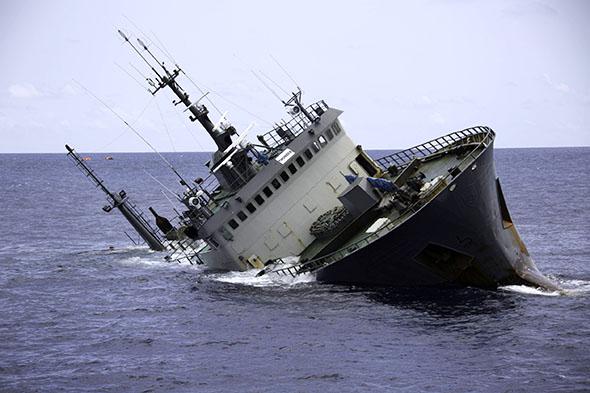A remarkable adventure came to a dramatic end Monday: The captain of a rogue fishing vessel that had been tailed by activists for more than three months apparently sank his ship off West Africa rather than face arrest with a load of illegally caught fish.
The pirate fishing ship’s crew was rescued by its pursuers, two ships belonging to the Sea Shepherd fleet, the Sam Simon and the Bob Barker, named after the late co-founder of The Simpsons and the former host of The Price Is Right.
Siddharth Chakravarty, the captain of the Sam Simon, said in a telephone interview Monday that the captain of the rogue ship Thunder, a Chilean, had told him that it sank because it had suffered a collision, an unlikely story. “We had crew on their boat and they noticed that all the doors had been tied open, which is the opposite of what you do if you’re taking on water after a collision,” he said. “Then the officers had neatly packed bags, so I have no doubt this was a planned, very intentional scuttling designed to remove evidence,” Chakravarty said.
Peter Hammarstedt, the captain of the Bob Barker, wrote in an email: “Our small boat crew reported that that the crew of the Thunder, including the officers, were cheering and chanting from the life rafts as it sank—hardly the actions of people who were shocked by the sinking of their vessel.”
The crew was placed on the back deck of the Sam Simon, which is piled with illegal nets that the Sam Simon’s crew had pulled out three months ago in the area where the Thunder was found laying illegal nets. The ships first encountered one another off Australian waters, where fishing is managed by the Commission for the Conservation of Antarctic Marine Living Resources.
The illegally caught white-fleshed fish is familiar to patrons of high-end restaurants: It’s marketed as the Chilean sea bass and is often the most expensive fish on the menu. But for marine biologists, it’s called toothfish, a bottom-dwelling species so named because it has two sharklike rows of teeth, one in front of the other. In the dark waters around Antarctica, it’s by far the biggest fish and sits at the top of the fish food chain, fearing only seals and killer whales. Its heart beats every six seconds. (The Antarctic variety, which lives closer to shore and often under ice, has an anti-freeze protein that allows it to thrive in waters colder than 32 degrees Fahrenheit.)
When they boarded the Thunder to help rescue its sailors, the Sea Shepherd crew saw Patagonian toothfish in the hold, though how much is not clear. The Thunder, which has changed names more than a dozen times over its decadelong career as a toothfish poacher, was registered in Lagos, Nigeria—except that last week, the Nigerian authorities delisted it, which made it a stateless, officially pirate vessel for the last few days of its life.
The Law of the Sea Convention recently ruled that flag states would from now on be held responsible for the illegal fishing carried out by their ships. The sinking came days after that decision. Duncan Currie, an international lawyer who filed a brief on the case, said “I think so” when asked by email whether the decision to hold countries responsible for poaching carried out under their flags would be a game-changer. Until now, flag states have not been held responsible for the damages, financial or environmental, wrought by boats fishing illegally.
The Thunder broke the law, according to Chakravarty, by using bottom-set gillnets, banned in the region since 2003 because of their deadly efficacy not only against toothfish but also against other species of no commercial value, known as by-catch.
“Of the five gill-net sets that my vessel recovered, we released back to the ocean about 50,000 kilos of toothfish,” he said in a telephone interview. “That’s about 20 toothfish per kilometer of net, which is a massive amount of fish. … In addition, there’s a horrific amount of by-catch, more than three times as much” compared to fishing with legal long-lines, which use baited hooks.
When the toothfish craze started in the 1990s, it was a free-for-all, and the population of these slow-growing fish, which can reach six feet in length, quickly plummeted. Eventually, the poaching was reduced to that carried out by what the Amsterdam-based Sea Shepherd calls the “Bandit Six,” vessels whose ownership has been traced to Spanish companies. The Thunder was one of these six.
Several times, these ships were found and even briefly impounded in ports around the world, but until now they were able to sell their valuable catch, pay small fines, and return to fishing.
This year, the Sea Shepherd, better known for obstructing whale-fishing vessels, launched Operation Icefish (as the toothfish is also known) in an attempt to prove that the “Bandit 6” could be found and arrested by the Australian and New Zealand authorities if only they tried, according to Paul Watson, Sea Shepherd’s founder and chief, who has complained that neither country has prosecuted the toothfish poachers with much vigor.
The Sea Shepherd’s approach worked. The Sam Simon found two vessels, the Kunlun, now under arrest in Phuket, Thailand, and the Yongding, which has vanished. (Meanwhile, a third member of the six, the Viking, is being held in Malaysia following an Interpol request.) The Bob Barker found the Thunder and tailed it for 110 days. The pursuers hoped the Thunder would run out of fuel and food and would head into port, where the crew would be arrested. “We never expected they would sink their ship,” said Chakravarty.
As night fell over the tropical eastern Atlantic, the Sam Simon was steaming toward the port of Sao Tome off the coast of Gabon, where the crew—comprising 30 Indonesian members and 10 officers from Spain, Portugal, and Chile—were to be turned over to the authorities.
